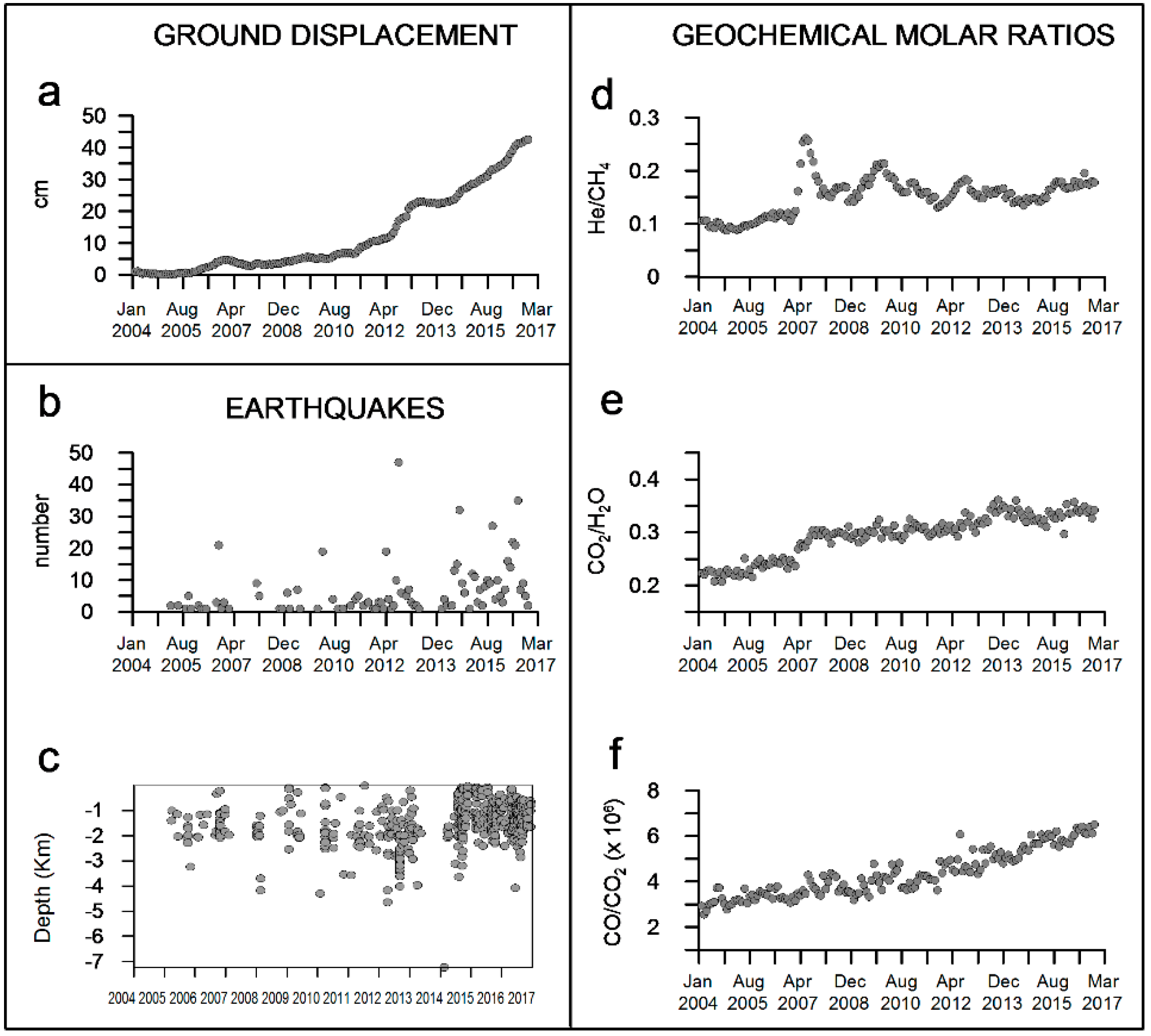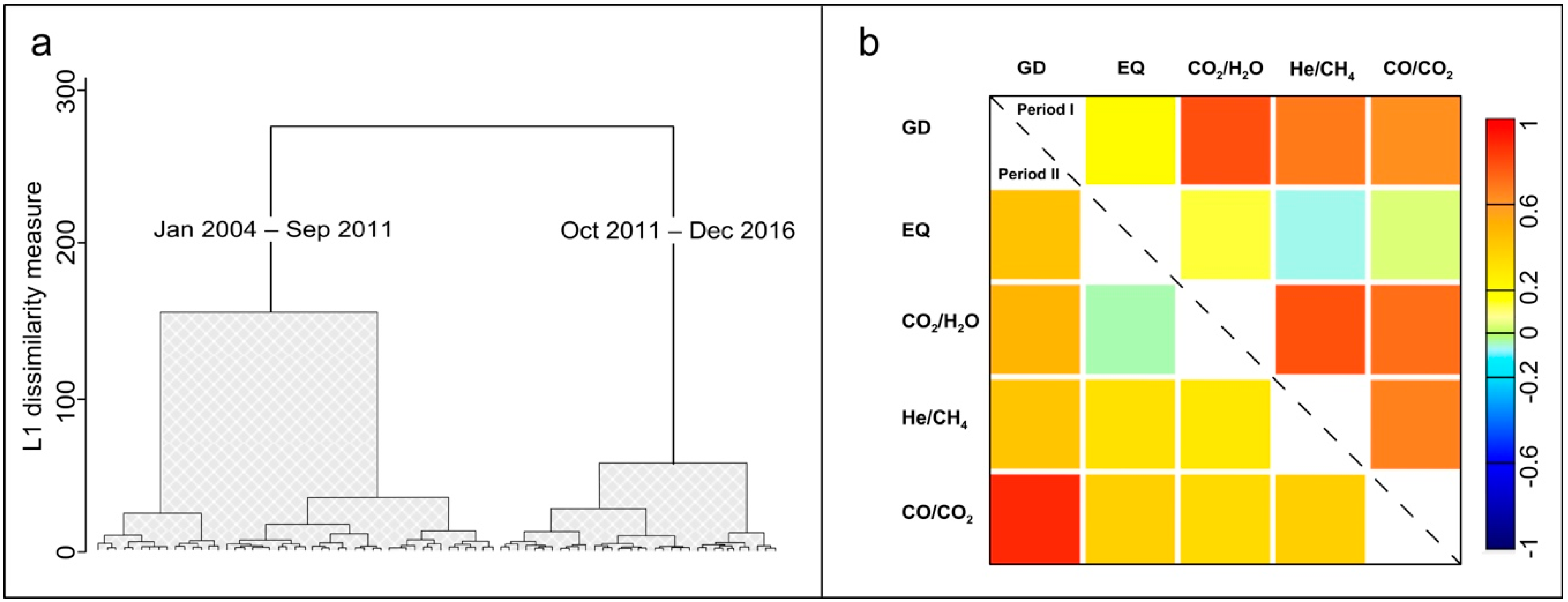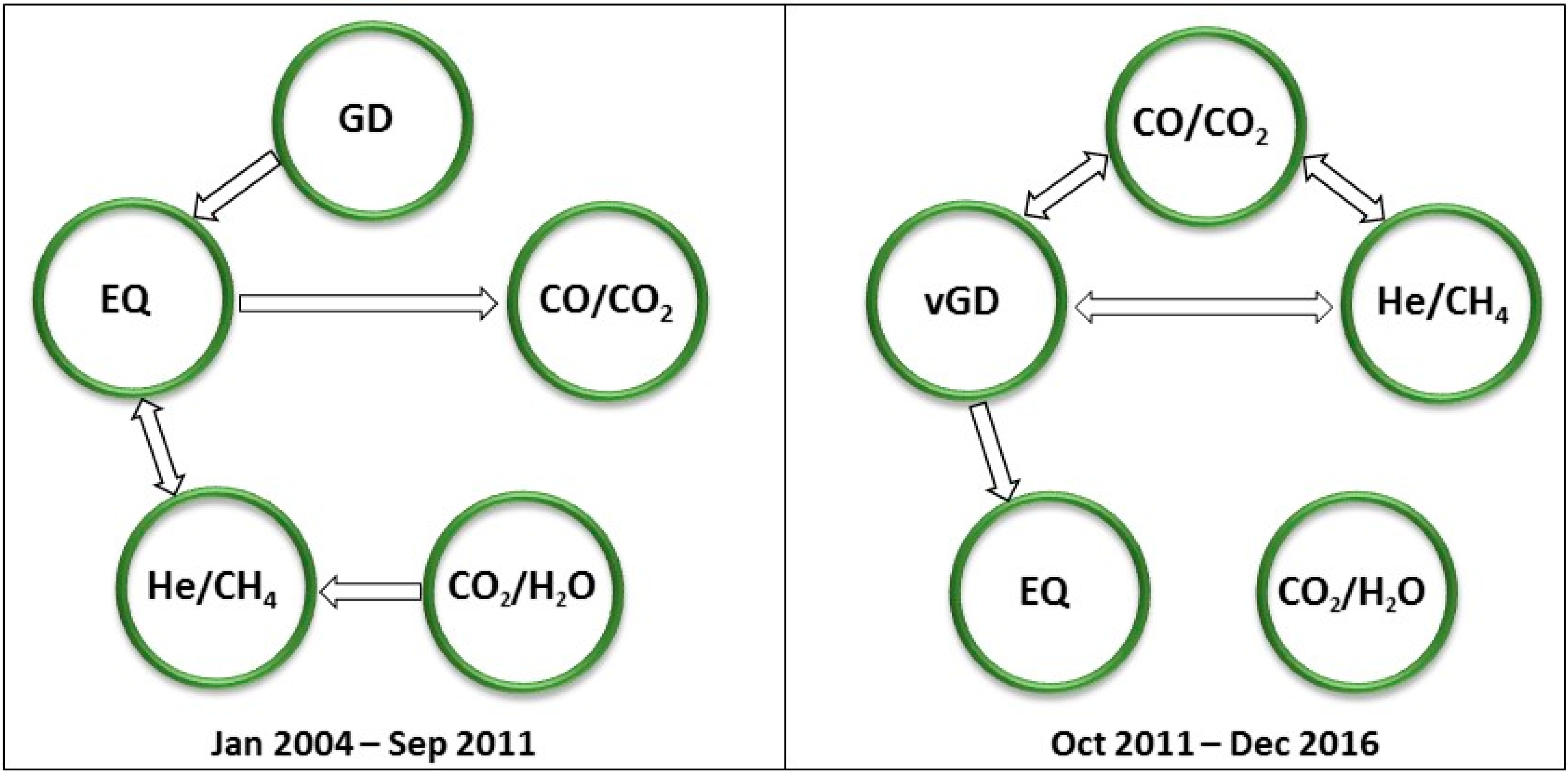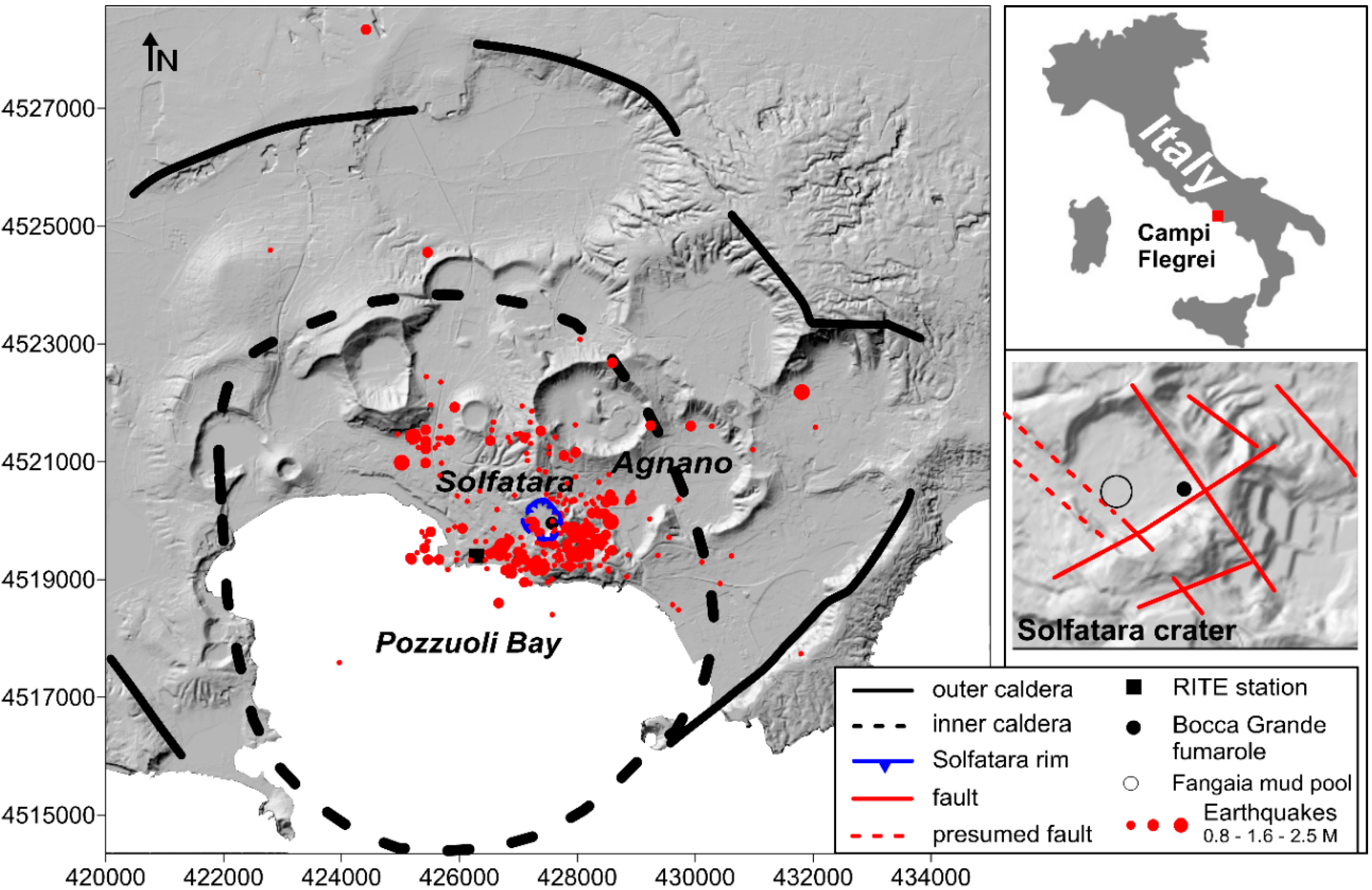Granger Causality Analysis of Geophysical, Geodetic and Geochemical Observations during Volcanic Unrest: A Case Study in the Campi Flegrei Caldera (Italy)
Abstract
1. Introduction
2. Study Area
3. Materials and Methods
3.1. Dataset
3.2. Hierarchical Agglomerative Clustering, Correlation and Granger Causality Analysis
4. Result
5. Discussion
6. Conclusions
Author Contributions
Funding
Acknowledgments
Conflicts of Interest
Appendix A
Appendix B
| Time Series | Mean | Median | st.dev. | Variance | Skewness | Kurtosis |
|---|---|---|---|---|---|---|
| GD (Jan 2004–Dec 2016) | 12.40 | 5.72 | 12.33 | 152.09 | 0.93 | 2.56 |
| ln GD (Jan 2004–Sep 2011) | 2.71 | 2.72 | 0.16 | 0.02 | −0.00 | 2.14 |
| ln GD (Oct 2011–Dec 2016) | 3.58 | 3.55 | 0.26 | 0.06 | −0.34 | 2.34 |
| EQ (Jan 2004–Dec 2016) | 3.65 | 1.00 | 7.05 | 49.77 | 3.23 | 15.55 |
| ln EQ (Jan 2004–Dec 2016) | 0.43 | 0.00 | 0.72 | 0.52 | 1.75 | 5.6 |
| ln EQ (Oct 2011–Dec 2016) | 1.55 | 1.61 | 1.08 | 1.17 | 0.10 | 2.08 |
| He/CH4 (Jan 2004–Dec 2016) | 0.15 | 0.16 | 0.04 | 0.00 | 0.47 | 4.27 |
| ln He/CH4 (Jan 2004–Sep 2011) | −1.95 | −1.88 | 0.30 | 0.09 | 0.09 | 2.12 |
| ln He/CH4 (Oct 2011–Dec 2016) | −1.84 | −1.84 | 0.09 | 0.01 | −0.12 | 2.03 |
| CO/CO2 (Jan 2004–Dec 2016) | 4.34 × 10−6 | 4.18 × 10−6 | 1.02 × 10−6 | 1.03 × 10−12 | 0.45 | 2.06 |
| ln CO/CO2 (Jan 2004–Sep 2011) | −12.53 | −12.53 | 0.13 | 0.02 | −0.04 | 2.61 |
| ln CO/CO2 (Oct 2011–Dec 2016) | −12.14 | −12.13 | 0.12 | 0.01 | −0.49 | 2.89 |
| CO2/H2O (Jan 2004–Dec 2016) | 0.29 | 0.30 | 0.04 | 0.00 | −0.58 | 2.26 |
| ln CO2/H2O (Jan 2004–Sep 2011) | −1.31 | −1.25 | 0.13 | 0.02 | −0.41 | 1.61 |
| ln CO2/H2O (Oct 2011–Dec 2016) | −1.11 | −1.12 | 0.05 | 0.00 | −0.25 | 2.40 |
References
- Cashman, K.V.; Sparks, R.S.J. How volcanoes work: A 25 year perspective. GSA Bul. 2013, 125, 664–690. [Google Scholar] [CrossRef]
- Acocella, V. Great challenges in volcanology: How does the volcano factory work? Front. Earth Sci. 2014, 2, 4. [Google Scholar] [CrossRef]
- Acocella, V.; Di Lorenzo, R.; Newhall, C.; Scandone, R. An overview of recent (1988 to 2014) caldera unrest: Knowledge and perspectives. Rev. Geophys. 2015, 53, 896–955. [Google Scholar] [CrossRef]
- Pearson, K. Mathematical contributions to the theory of evolution, on a form of spurious correlation which may arise when indices are used in the measurement of organs. Proc. R. Soc. Lond. 1897, 60, 489–498. [Google Scholar]
- Box, G. Time Series Analysis: Forecasting and Control; Prentice Hall: Englewood Cliffs, NJ, USA, 1994. [Google Scholar]
- Lütkepohl, H. New Introduction to Multiple Time Series Analysis; Springer: New York, NY, USA, 2005. [Google Scholar]
- Granger, C.W.J. Investigating causal relations by econometric models and cross-spectral methods. Econometrica 1969, 37, 424–438. [Google Scholar] [CrossRef]
- Granger, C.W. Testing for causality: A personal viewpoint. J. Econ. Dyn. Control 1980, 2, 329–352. [Google Scholar] [CrossRef]
- Kaufmann, R.K.; Stern, D.I. Evidence for human influence on climate from hemispheric temperature relations. Nature 1997, 388, 39–44. [Google Scholar] [CrossRef]
- Kang, J.; Larsson, R. What is the link between temperature and carbon dioxide levels? A Granger causality analysis based on ice core data. Theor. Appl. Climatol. 2014, 116, 537–548. [Google Scholar] [CrossRef]
- Triacca, U.; Attanasio, A.; Pasini, A. Anthropogenic global warming hypothesis: Testing its robustness by Granger causality analysis. Environmetrics 2013, 24, 260–268. [Google Scholar] [CrossRef]
- Leggett, L.M.W.; Ball, D.A. Granger causality from changes in level of atmospheric CO2 to global surface temperature and the El Niño–Southern Oscillation, and a candidate mechanism in global photosynthesis. Atmos. Chem. Phys. 2015, 15, 11571–11592. [Google Scholar] [CrossRef]
- Sugihara, G.; May, R.; Ye, H.; Hsieh, C.; Deyle, E.; Fogarty, M.; Munch, S. Detecting Causality in Complex Ecosystems. Science 2012, 338, 496–500. [Google Scholar] [CrossRef]
- Hatala, J.A.; Detto, M.; Baldocchi, D.D. Gross ecosystem photosynthesis causes a diurnal pattern in methane emission from rice. Geophys. Res. Lett. 2012, 39, L06409. [Google Scholar] [CrossRef]
- Detto, M.; Bohrer, G.; Nietz, J.G.; Maurer, K.D.; Vogel, C.S.; Gough, C.M.; Curtis, P.S. Multivariate conditional Granger causality analysis for lagged response of soil respiration in a temperate forest. Entropy 2013, 15, 4266–4284. [Google Scholar] [CrossRef]
- Damos, P. Using multivariate cross correlations, Granger causality and graphical models to quantify spatiotemporal synchronization and causality between pest populations. BMC Ecol. 2016, 16, 33. [Google Scholar] [CrossRef] [PubMed]
- Singh, N.K.; Borrok, D.M. A Granger causality analysis of groundwater patterns over a half-century. Sci. Rep. 2019, 9, 1–8. [Google Scholar] [CrossRef]
- Kamiński, M.; Ding, M.; Truccolo, W.A.; Bressler, S.L. Evaluating causal relations in neural systems: Granger causality, directed transfer function and statistical assessment of significance. Biol. Cybern. 2001, 85, 145–157. [Google Scholar] [CrossRef]
- Ding, M.; Chen, Y.; Bressler, S.L. Granger causality: Basic theory and application to neuroscience. In Handbook of Time Series Analysis: Recent Theoretical Developments and Applications; Schelter, B., Winterhalder, M., Timmer, J., Eds.; Wiley-VCH Verlag: Weinhein, Germany, 2006; p. 437. [Google Scholar]
- Seth, A.K.; Edelman, G.M. Distinguishing Causal Interactions in Neural Populations. Neural Comput. 2007, 19, 910–933. [Google Scholar] [CrossRef]
- Bose, E.; Hravnak, M.; Sereika, S. Vector Autoregressive (VAR) Models and Granger Causality in Time Series Analysis in Nursing Research: Dynamic Changes Among Vital Signs Prior to Cardiorespiratory Instability Events as an Example. Nurs. Res. 2017, 66, 12–19. [Google Scholar] [CrossRef]
- Chiodini, G.; Vandemeulebrouck, J.; Caliro, S.; D’Auria, L.; De Martino, P.; Mangiacapra, A.; Petrillo, Z. Evidence of thermal-driven processes triggering the 2005–2014 unrest at Campi Flegrei caldera. Earth Planet Sci. Lett. 2015, 414, 58–67. [Google Scholar] [CrossRef]
- Cardellini, C.; Chiodini, G.; Frondini, F.; Avino, R.; Bagnato, E.; Caliro, S.; Lelli, M.; Rosiello, A. Monitoring diffuse volcanic degassing during volcanic unrests: The case of Campi Flegrei (Italy). Sci. Rep. 2017, 7, 1–15. [Google Scholar] [CrossRef]
- Petrosino, S.; Cusano, P.; Madonia, P. Tidal and hydrological periodicities of seismicity reveal new risk scenarios at Campi Flegrei caldera. Sci. Rep. 2018, 8, 1–12. [Google Scholar] [CrossRef] [PubMed]
- Rouwet, D.; Sandri, L.; Marzocchi, W.; Gottsmann, J.; Selva, J.; Tonini, R.; Papale, P. Recognizing and tracking volcanic hazards related to non-magmatic unrest: A review. J. Appl. Volcanol. 2014, 3, 1–17. [Google Scholar] [CrossRef]
- Rosi, M.; Sbrana, A. Phlegrean fields. Quaderni Ricerca Scientifica 1987, 9, 114. [Google Scholar]
- Orsi, G.; De Vita, S.; Di Vito, M. The restless, resurgent Campi Flegrei nested caldera (Italy): Constraints on its evolution and configuration. J. Volcanol. Geotherm. Res. 1996, 74, 179–214. [Google Scholar] [CrossRef]
- Civetta, L.; Orsi, G.; Pappalardo, L.; Fisher, R.V.; Heiken, G.; Ort, M. Geochemical zoning, mingling, eruptive dynamics and depositional processes—The Campanian Ignimbrite, Campi Flegrei caldera, Italy. J. Volcanol. Geotherm. Res. 1997, 75, 183–219. [Google Scholar] [CrossRef]
- Acocella, V. Evaluating fracture patterns within a resurgent caldera: Campi Flegrei, Italy. Bull. Volcanol. 2010, 72, 623–638. [Google Scholar] [CrossRef]
- Isaia, R.; D’Antonio, M.; Dell’Erba, F.; Di Vito, M.; Orsi, G. The Astroni volcano: The only example of closely spaced eruptions in the same vent area during the recent history of the Campi Flegrei caldera (Italy). J. Volcanol. Geotherm. Res. 2004, 133, 171–192. [Google Scholar] [CrossRef]
- Di Vito, M.; Lirer, L.; Mastrolorenzo, G.; Rolandi, G. The 1538 Monte Nuovo eruption (Campi Flegrei, Italy). Bull. Volcanol. 1987, 49, 608–615. [Google Scholar] [CrossRef]
- Orsi, G.; Civetta, L.; Del Gaudio, C.; De Vita, S.; Di Vito, M.A.; Isaia, R.; Petrazzuoli, S.M.; Ricciardi, G.P.; Ricco, C. Short-term ground deformations and seismicity in the resurgent Campi Flegrei caldera (Italy): An example of active block-resurgence in a densely populated area. J. Volcanol. Geotherm. Res. 1999, 91, 415–451. [Google Scholar] [CrossRef]
- Del Gaudio, C.; Aquino, I.; Ricciardi, G.P.; Ricco, C.; Scandone, R. Unrest episodes at Campi Flegrei: A reconstruction of vertical ground movements during 1905–2009. J. Volcanol. Geotherm. Res. 2010, 195, 48–56. [Google Scholar] [CrossRef]
- De Natale, G.; Pingue, F.; Allard, P.; Zollo, A. Geophysical and geochemical modelling of the 1982–1984 unrest phenomena at Campi Flegrei caldera (southern Italy). J. Volcanol. Geotherm. Res. 1991, 48, 199–222. [Google Scholar] [CrossRef]
- Chiodini, G.; Paonita, A.; Aiuppa, A.; Costa, A.; Caliro, S.; De Martino, P.; Acocella, V.; Vandemeulebrouck, J. Magmas near the critical degassing pressure drive volcanic unrest towards a critical state. Nat. Commun. 2016, 7, 1–9. [Google Scholar] [CrossRef] [PubMed]
- Judenherc, S.; Zollo, A. The Bay of Naples (southern Italy): Constraints on the volcanic structures inferred from a dense seismic survey. J. Geophys. Res. 2004, 109, B10312. [Google Scholar] [CrossRef]
- Zollo, A.; Maercklin, N.; Vassallo, M.; Dello Iacono, D.; Virieux, J.; Gasparini, P. Seismic reflections reveal a massive melt layer feeding Campi Flegrei caldera. Geophys. Res. Lett. 2008, 35, L12306. [Google Scholar] [CrossRef]
- Vanorio, T.; Virieux, J.; Capuano, P.; Russo, G. Three-dimensional seismic tomography from P wave and S wave microearthquake travel times and rock physics characterization of the Campi Flegrei Caldera. J. Geophys. Res. Solid Earth 2005, 110, B3. [Google Scholar] [CrossRef]
- Battaglia, J.; Zollo, A.; Virieux, J.; Iacono, D.D. Merging active and passive data sets in traveltime tomography: The case study of Campi Flegrei caldera (Southern Italy). Geophys. Prospect. 2008, 56, 555–573. [Google Scholar] [CrossRef]
- De Siena, L.; Amoruso, A.; Pezzo, E.D.; Wakeford, Z.; Castellano, M.; Crescentini, L. Space-weighted seismic attenuation mapping of the aseismic source of Campi Flegrei 1983–1984 unrest. Geophys. Res. Lett. 2017, 44, 1740–1748. [Google Scholar]
- De Siena, L.; Chiodini, G.; Vilardo, G.; Del Pezzo, E.; Castellano, M.; Colombelli, S.; Tisato, N.; Ventura, G. Source and dynamics of a volcanic caldera unrest: Campi Flegrei, 1983–84. Sci. Rep. 2017, 7, 1–13. [Google Scholar] [CrossRef]
- Calò, M.; Tramelli, A. Anatomy of the campi flegrei caldera using enhanced seismic tomography models. Sci. Rep. 2018, 8, 1–12. [Google Scholar] [CrossRef]
- Siniscalchi, A.; Tripaldi, S.; Romano, G.; Chiodini, G.; Improta, L.; Petrillo, Z.; D’Auria, L.; Caliro, S.; Avino, R. Reservoir structure and hydraulic properties of the Campi Flegrei geothermal system inferred by audiomagnetotelluric, geochemical, and seismicity study. J. Geophys. Res. Solid Earth 2019, 124, 5336–5356. [Google Scholar] [CrossRef]
- Troiano, A.; Di Giuseppe, M.G.; Patella, D.; Troise, C.; De Natale, G. Electromagnetic outline of the Solfatara–Pisciarelli hydrothermal system, Campi Flegrei (southern Italy). J. Volcanol. Geotherm. Res. 2014, 277, 9–21. [Google Scholar] [CrossRef]
- Gresse, M.; Vandemeulebrouck, J.; Byrdina, S.; Chiodini, G.; Revil, A.; Johnson, T.C.; Ricci, T.; Vilardo, G.; Mangiacapra, A.; Lebourg, T.; et al. Three-dimensional electrical resistivity tomography of the Solfatara crater (Italy): Implication for the multiphase flow structure of the shallow hydrothermal system. J. Geophys. Res. Solid Earth 2017, 122, 8749–8768. [Google Scholar] [CrossRef]
- Troise, C.; De Natale, G.; Schiavone, R.; Somma, R.; Moretti, R. The Campi Flegrei caldera unrest: Discriminating magma intrusions from hydrothermal effects and implications for possible evolution. Earth Sci. Rev. 2019, 188, 108–122. [Google Scholar] [CrossRef]
- Moretti, R.; De Natale, G.; Troise, C. Hydrothermal versus magmatic: Geochemical views and clues into the unrest dilemma at Campi Flegrei. In Vesuvius, Campi Flegrei, and Campanian Volcanism; Elsevier: Amsterdam, The Netherlnads, 2020; pp. 371–406. [Google Scholar]
- Chiodini, G.; Selva, J.; Del Pezzo, E.; Marsan, D.; De Siena, L.; D’auria, L.; Bianco, F.; Caliro, S.; De Martino, P.; Ricciolino, P.; et al. Clues on the origin of post-2000 earthquakes at Campi Flegrei caldera (Italy). Sci. Rep. 2017, 7, 1–10. [Google Scholar] [CrossRef]
- Di Vito, M.A.; Isaia, R.; Orsi, G.; Southon, J.D.; De Vita, S.; d’Antonio, M.; Pappalardo, L.; Piochi, M. Volcanism and deformation since 12,000 years at the Campi Flegrei caldera (Italy). J. Volcanol. Geotherm. Res. 1999, 91, 221–246. [Google Scholar] [CrossRef]
- De Martino, P.; Tammaro, U.; Obrizzo, F. GPS time series at Campi Flegrei caldera (2000–2013). Ann. Geophys. 2014, 57, S0213. [Google Scholar]
- Petrillo, Z.; D’Auria, L.; Mangiacapra, A.; Chiodini, G.; Caliro, S.; Scippacercola, S. A perturbative approach for modeling short-term fluid-driven ground deformation episodes on volcanoes: A case study in the Campi Flegrei caldera (Italy). J. Geophys. Res. Solid Earth 2019, 124, 1036–1056. [Google Scholar] [CrossRef]
- Istituto Nazionale di Geofisica e Vulcanologia. Osservatorio Vesuviano. Database Sismologico dei Vulcani della Campania. Available online: http://sismolab.ov.ingv.it/sismo/index.php?PAGE=SISMO/last&area=Flegrei&rmenu=on (accessed on 24 April 2020).
- Chiodini, G.; Giudicepietro, F.; Vandemeulebrouck, J.; Aiuppa, A.; Caliro, S.; De Cesare, W.; Tamburello, G.; Avino, R.; Orazi, M.; D’Auria, L. Fumarolic tremor and geochemical signals during a volcanic unrest. Geology 2017, 45, 1131–1134. [Google Scholar] [CrossRef]
- Aitchison, J. A new approach to null correlations of proportions. Math. Geol. 1981, 13, 175–189. [Google Scholar] [CrossRef]
- Aitchison, J. The statistical analysis of compositional data (with discussion). J. R. Stat. Soc. 1982, B44, 139–177. [Google Scholar]
- Lowenstern, J.B. Carbon dioxide in magmas and implications for hydrothermal systems. Miner. Deposita 2001, 36, 490–502. [Google Scholar] [CrossRef]
- Chiodini, G.; Marini, L. Hydrothermal gas equilibria: The H2O-H2-CO2-CO-CH4 system. Geochim. Cosmochim. Acta 1998, 62, 2673–2687. [Google Scholar] [CrossRef]
- Reimann, C.; Filzmoser, P. Normal and lognormal data distribution in geochemistry: Death of a myth. Consequences for the statistical treatment of geochemical and environmental data. Environ. Geol. 2000, 39, 1001–1014. [Google Scholar] [CrossRef]
- Shapiro, S.S.; Francia, R.S. An approximate analysis of variance test for normality. J. Am. Stat. 1972, 67, 215–216. [Google Scholar] [CrossRef]
- Doornik, J.A.; Hansen, H. An omnibus test for univariate and multivariate normality. Oxf. Bull. Econ. Stat. 2008, 70, 927–939. [Google Scholar] [CrossRef]
- Gordon, A.D. Classification: Methods for the Exploratory Analysis of Multivariate Data; Chapman and Hall: London, UK, 1981. [Google Scholar]
- Ward, J.H., Jr. Hierarchical grouping to optimize an objective function. J. Am. Stat. Assoc. 1963, 58, 236–244. [Google Scholar] [CrossRef]
- Spearman, C. The Proof and Measurement of Association between Two Things. Am. J. Psychol. 1904, 15, 72–101. [Google Scholar] [CrossRef]
- Mann, H.B. Non-parametric tests against trend. Econometrica 1945, 13, 163–171. [Google Scholar] [CrossRef]
- Kendall, M.G. Rank Correlation Methods, 4th ed.; Charles Griffin: London, UK, 1975. [Google Scholar]
- Dickey, D.A.; Fuller, W.A. Distribution of the estimators for autoregressive time series with a unit root. J. Am. Stat. Assoc. 1979, 74, 427–431. [Google Scholar]
- Akaike, H. Statistical predictor identification. Ann. Inst. Stat. Math. 1970, 22, 203–217. [Google Scholar] [CrossRef]
- Hannan, E.J.; Quinn, B.G. The determination of the order of an autoregression. J. R. Stat. Soc. Ser. B 1979, 41, 190–195. [Google Scholar] [CrossRef]
- Akaike, H. Information theory and an extension of the maximum likelihood principle. In Proceedings of the Second International Symposium on Information Theory, Tsahkadsor, Armenia, USSR, 2–8 September 1971; 1973; pp. 267–281. [Google Scholar]
- Akaike, H. A new look at the statistical model identification. IEEE Trans. Autom. Control 1974, 19, 716–723. [Google Scholar] [CrossRef]
- Hamilton, J.D.; Susmel, R. Autoregressive conditional heteroskedasticity and changes in regime. J. Econ. 1994, 64, 307–333. [Google Scholar] [CrossRef]
- Dzurisin, D. A comprehensive approach to monitoring volcano deformation as a window on the eruption cycle. Rev. Geophys. 2003, 41, 1001. [Google Scholar] [CrossRef]
- Voight, B.R.; Hoblitt, A.; Clarke, A.; Lockhart, A.; Miller, L.; Lynch, L.; McMahon, J. Remarkable cyclic ground deformation monitored in real-time on Montserrat, and its use in eruption forecasting. Geophys. Res. Lett. 1998, 25, 3405–3408. [Google Scholar] [CrossRef]
- White, R.; McCausland, W. Volcano-tectonic earthquakes: A new tool for estimating intrusive volumes and forecasting eruptions. J. Volcanol. Geotherm. Res. 2016, 309, 139–155. [Google Scholar] [CrossRef]
- Gottsmann, J.; Carniel, R.; Coppo, N.; Wooller, L.; Hautmann, S.; Rymer, H. Oscillations in hydrothermal systems as a source of periodic unrest at caldera volcanoes: Multiparameter insights from Nisyros, Greece. Geophys. Res. Lett. 2007, 34, L07307. [Google Scholar] [CrossRef]
- Saccorotti, G.S.; Petrosino, F.; Bianco, M.; Castellano, D.; Galluzzo, M.; La Rocca, E.; Del Pezzo, L.; Zaccarelli, C.P. Seismicity associated with the 2004–2006 renewed ground uplift at Campi Flegrei Caldera, Italy. Phys. Earth Planet. Inter. 2007, 165, 14–24. [Google Scholar] [CrossRef]
- D’Auria, L.; Giudicepietro, F.; Aquino, I.; Borriello, G.; Del Gaudio, C.; Lo Bascio, D.; Martini, M.; Ricciardi, G.P.; Ricciolino, P.; Ricco, C. Repeated fluid-transfer episodes as a mechanism for the recent dynamics of Campi Flegrei caldera (1989–2010). J. Geophys. Res. 2011, 116, B04313. [Google Scholar] [CrossRef]
- Sibson, R.H.; Moore, J.M.M.; Rankin, A.H. Seismic pumping—A hydrothermal fluid transport mechanism. J. Geol. Soc. 1975, 131, 653–659. [Google Scholar] [CrossRef]
- Todesco, M.; Rinaldi, A.P.; Bonafede, M. Modeling of unrest signals in heterogeneous hydrothermal systems. J. Geophys. Res. 2010, 115, B09213. [Google Scholar] [CrossRef]
- Morrow, C.A.; Moore, D.E.; Lockner, D.A. Permeability reduction in granite under hydrothermal conditions. J. Geophys. Res. 2001, 106, 30551–30560. [Google Scholar] [CrossRef]
- Heap, M.J.; Baud, P.; Meredith, P.G.; Vinciguerra, S.; Reuschlé, T. The permeability and elastic moduli of tuff from Campi Flegrei, Italy: Implications for ground deformation modelling. Solid Earth 2014, 5, 25. [Google Scholar] [CrossRef]
- Stern, D.I.; Kaufmann, R.K. Anthropogenic and natural causes of climate change. Clim. Change 2014, 122, 257–269. [Google Scholar] [CrossRef]
- Chiodini, G.; Caliro, S.; Avino, R.; Bagnato, E.; Capecchiacci, F.; Carandente, A.; Cardellini, C.; Minopoli, C.; Tamburello, G.; Tripaldi, S.; et al. Forthcoming. The Campi Flegrei hydrothermal system. In Campi Flegrei; Orsi, G., Civetta, L., D’Antonio, M., Eds.; ISBN 978-3-642-37060 in Book Series “Active Volcanoes of the World”; Springer Verlag: Berlin, Germany.
- Ricco, C.; Petrosino, S.; Aquino, I.; Del Gaudio, C.; Falanga, M. Some investigations on a possible relationship between ground deformation and seismic activity at Campi Flegrei and Ischia volcanic areas (Southern Italy). Geoscience 2019, 9, 222. [Google Scholar] [CrossRef]
- Cappa, F.; Rutqvist, J.; Yamamoto, K. Modeling crustal deformation and rupture processes related to upwelling of deep CO2-rich fluids during the 1965–1967 Matsushiro earthquake swarm in Japan. J. Geophys. Res. 2009, 114, B10304. [Google Scholar] [CrossRef]
- Yukutake, Y.; Honda, R.; Harada, M.; Arai, R.; Matsubara, M. A magma-hydrothermal system beneath Hakone volcano, central Japan, revealed by highly resolved velocity structures. J. Geophys. Res. Solid Earth 2015, 120, 3293–3308. [Google Scholar] [CrossRef]
- Ohba, T.; Yaguchi, M.; Nishino, K.; Numanami, N.; Daita, Y.; Sukigara, C.; Masanori, I.; Tsunogai, U. Time variations in the chemical and isotopic composition of fumarolic gases at Hakone volcano, Honshu Island, Japan, over the earthquake swarm and eruption in 2015, interpreted by magma sealing model. Earth Planets Space 2019, 71, 48. [Google Scholar] [CrossRef]
- Geweke, J. Measurement of linear dependence and feedback between multiple time series. J. Am. Stat. 1982, 77, 304–313. [Google Scholar] [CrossRef]



| Granger Causality Wald Test | Jan 2004–Sep 2011 | Oct 2011–Dec 2016 | |
|---|---|---|---|
| Variable Y | Variable X | F (P-value) | F (P-value) (*) |
| GD | EQ | 0.586 (0.6260) | 1.212 (0.3167) |
| GD | He/CH4 | 1.394 (0.2525) | 2.174 (0.0910) |
| GD | CO2/H2O | 0.280 (0.8391) | 0.158 (0.9234) |
| GD | CO/CO2 | 1.453 (0.2356) | 2.761 (0.0535) |
| EQ | GD | 5.200 (0.0028) | 2.721 (0.0561) |
| EQ | He/CH4 | 2.709 (0.0524) | 0.399 (0.7544) |
| EQ | CO2/H2O | 1.513 (0.2196) | 1.179 (0.3290) |
| EQ | CO/CO2 | 1.559 (0.2079) | 0.528 (0.6654) |
| He/CH4 | GD | 0.637 (0.5936) | 4.219 (0.0065) |
| He/CH4 | EQ | 3.688 (0.0163) | 0.269 (0.8473) |
| He/CH4 | CO2/H2O | 3.172 (0.0301) | 0.579 (0.6317) |
| He/CH4 | CO/CO2 | 1.281 (0.2883) | 3.165 (0.0339) |
| CO2/H2O | GD | 1.009 (0.3944) | 1.810 (0.1596) |
| CO2/H2O | EQ | 0.985 (0.4053) | 1.456 (0.2398) |
| CO2/H2O | He/CH4 | 0.241 (0.8676) | 0.679 (0.5696) |
| CO2/H2O | CO/CO2 | 0.870 (0.4614) | 0.117 (0.9496) |
| CO/CO2 | GD | 0.312 (0.8166) | 2.272 (0.0937) |
| CO/CO2 | EQ | 3.543 (0.0194) | 0.666 (0.5772) |
| CO/CO2 | He/CH4 | 1.379 (0.2570) | 2.634 (0.0619) |
| CO/CO2 | CO2/H2O | 1.075 (0.3660) | 0.547 (0.6530) |
© 2020 by the authors. Licensee MDPI, Basel, Switzerland. This article is an open access article distributed under the terms and conditions of the Creative Commons Attribution (CC BY) license (http://creativecommons.org/licenses/by/4.0/).
Share and Cite
Tripaldi, S.; Scippacercola, S.; Mangiacapra, A.; Petrillo, Z. Granger Causality Analysis of Geophysical, Geodetic and Geochemical Observations during Volcanic Unrest: A Case Study in the Campi Flegrei Caldera (Italy). Geosciences 2020, 10, 185. https://doi.org/10.3390/geosciences10050185
Tripaldi S, Scippacercola S, Mangiacapra A, Petrillo Z. Granger Causality Analysis of Geophysical, Geodetic and Geochemical Observations during Volcanic Unrest: A Case Study in the Campi Flegrei Caldera (Italy). Geosciences. 2020; 10(5):185. https://doi.org/10.3390/geosciences10050185
Chicago/Turabian StyleTripaldi, Simona, Sergio Scippacercola, Annarita Mangiacapra, and Zaccaria Petrillo. 2020. "Granger Causality Analysis of Geophysical, Geodetic and Geochemical Observations during Volcanic Unrest: A Case Study in the Campi Flegrei Caldera (Italy)" Geosciences 10, no. 5: 185. https://doi.org/10.3390/geosciences10050185
APA StyleTripaldi, S., Scippacercola, S., Mangiacapra, A., & Petrillo, Z. (2020). Granger Causality Analysis of Geophysical, Geodetic and Geochemical Observations during Volcanic Unrest: A Case Study in the Campi Flegrei Caldera (Italy). Geosciences, 10(5), 185. https://doi.org/10.3390/geosciences10050185






